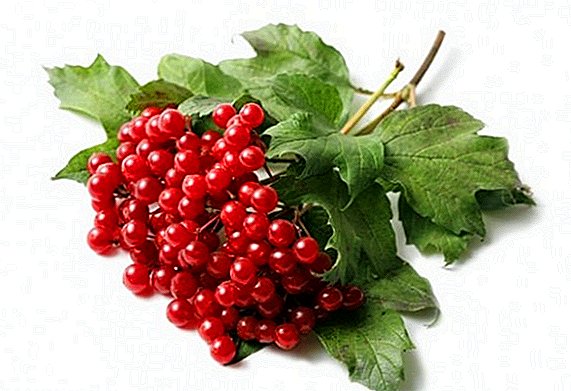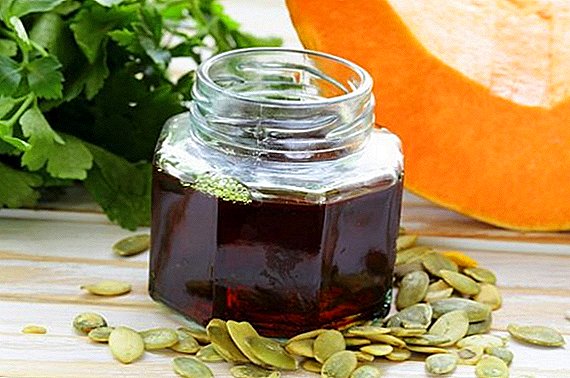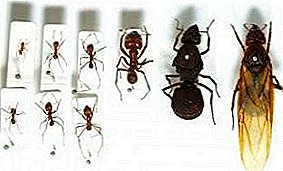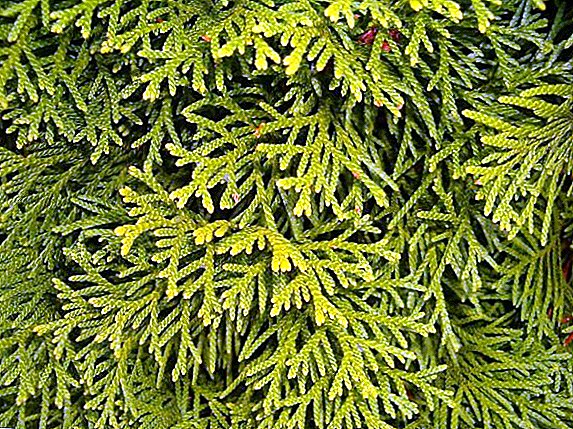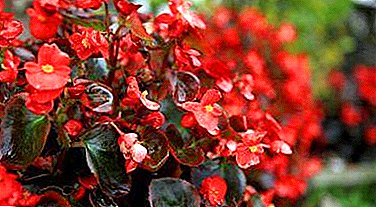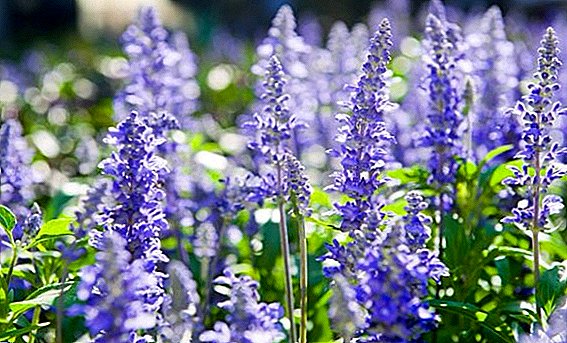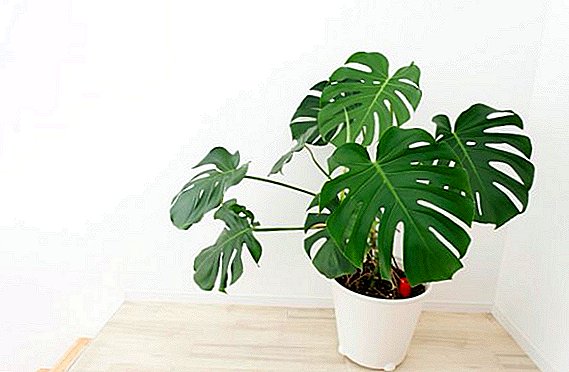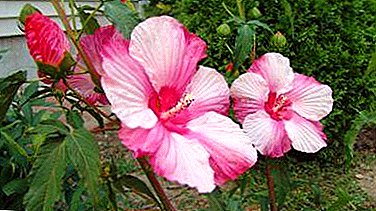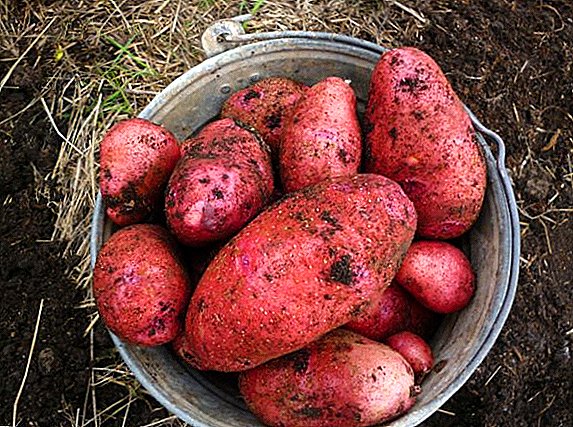 Rodrigo potatoes are a versatile medium-early variety of table purpose, which has gained its popularity due to high yields, quick adaptation to weather conditions and simple cultivation processes. This variety also owes its demand for gardeners excellent taste characteristics. If you are not afraid to try something new, we offer you to get acquainted with the description of this variety, the rules of its planting and the characteristics of care.
Rodrigo potatoes are a versatile medium-early variety of table purpose, which has gained its popularity due to high yields, quick adaptation to weather conditions and simple cultivation processes. This variety also owes its demand for gardeners excellent taste characteristics. If you are not afraid to try something new, we offer you to get acquainted with the description of this variety, the rules of its planting and the characteristics of care.
Selection
Potatoes "Rodrigo" (in official sources sometimes you can find the name "Rodrigue") - this is a novelty of German selection. Its originator (the agrofirm which created the variety) is Solana GmbH & Co. KG (Germany). This versatile potato has already gained popularity in our latitudes.
Botanical description
Coming from Germany has a fairly presentable appearance. The following external varietal characteristics are characteristic of "Rodrigo".
Such potato varieties as “Luck”, “Kiwi”, “Impala”, “Lorch”, “Zhuravinka”, “Cherry”, “Queen Anna”, “Sante”, “Ilyinsky”, “Picasso” and “ Irbitsky ".
Tubers
Potatoes have oblong tubers (elongated oval shape). The sizes are rather large (approximately with the fist of an adult), the average weight is 80-150 g. With good climatic conditions, and also if the plantings receive proper care, you can harvest tubers weighing 250-300 g and even about 500 g. In a mature specimen, the peel is smooth, dense, but quite thin. The skin color varies from bright pink to dark red. A few small eyes are located exclusively on the surface, which greatly simplifies the process of cleaning potatoes.
Important! In order to preserve all the useful elements of "Rodrigo" it is desirable to cook (boil or bake) unpeeled, that is, in the skins.The flesh is tight, has an intense yellow color, sometimes it is light yellow or cream. After heat treatment, the color of the pulp becomes brighter. The best taste properties are varieties with yellow pulp. "Rodrigo" is no exception - the variety is marked by excellent taste characteristics. The root crop has a delicate aroma and a pleasant taste with hints of sweetness. A low concentration of dry substances (starch) - about 12-15% - determines the versatility of the destination of this class. The shape of the tubers is well preserved during heat treatment (cooking or roasting), without becoming a porridge.

Bushes
Semi-sprawling plants, of medium height or slightly above average (stem length - 75-80 cm). Each bush includes 3-5 shoots. As the potatoes ripen, the shoots slowly wither, the tops become yellow, the bush seems to "split." The leaves are relatively small, they are painted in a dark green tone. Leaves are characterized by medium size, wrinkled structure, typical potato form (without omission).
The edges of the leaf blades have a moderate waviness. Blooming flowers are not too plentiful. The size of the flowers are medium large. Petals lilac-pink, sometimes reddish, corollas white.
We grow potatoes from seeds, under straw and plant them before winter.
Characteristic variety
The massive interest in the Rodrigo variety is due to its undeniable merits. And the handsome pink is constant in its quality attributes.
Disease resistance
German native belongs to the category of medium-resistant varieties. This degree of resistance applies to most types of potato diseases and viruses that other varieties suffer from. The pink beauty is not afraid of even tuber cancer, nematode, scab and late blight. 
Terms of ripening
"Rodrigo" is included in the group of mid-early species. The length of the growing season (since planting) is 70-85 days. However, conditional maturity comes before the technical. If you do not have enough patience, you can dig a couple of bushes before the time of full ripening (about 60 days after the shoots seem). The peel of young root vegetables is thin, easily lagging behind the pulp - all this indicates that "Rodrigo" is ready to eat.
Did you know? The record for potato cleaning belongs to German Linde Thomsen - a woman processed 10.49 kg of potatoes in just 10 minutes.
Yield
The yield of the German native is amazing - sprouts are shown quickly and massively. About 8-10 large root crops can be removed from a single bush, and more than 600 kg of large tubers from a weave. On an industrial scale, the average yield is 1.5-2 kg per square meter (maximum - 4 kg) or 45 tons per 1 hectare. 
Stickiness
The variety is marked by good keeping quality (ability to store) and a high presentation type of crop. 90-95% of potatoes from the total number of specimens taken from one bush have a good marketability (presentability). All samples are well developed, the integrity of the potato is almost not observed, and they do not freeze during storage.
Growing regions
Cultivation of "Rodrigo" is possible in all regions of the European continent, in any climatic zones. Tests of a variety carried out in different geographical areas of Europe have shown successful results: the variety is not afraid of heat, cold or drought. The potato feels great in the northern and southern areas, although experts recommended only in areas with a warm subtropical climate.  Amateur vegetable growers from different countries grow this potato at the dacha plots and with their reviews confirm the success of the results. It is worth noting that the variety is very popular in the Russian Federation, where it is recommended for cultivation in most regions. According to experts, the most preferable region in this case is the Middle Volga region. However, the handsome pink shows excellent results in regions that can be called "areas of high-risk tillage."
Amateur vegetable growers from different countries grow this potato at the dacha plots and with their reviews confirm the success of the results. It is worth noting that the variety is very popular in the Russian Federation, where it is recommended for cultivation in most regions. According to experts, the most preferable region in this case is the Middle Volga region. However, the handsome pink shows excellent results in regions that can be called "areas of high-risk tillage."
Landing rules
"Rodrigo" is known for its overall simplicity. However, if you want to get a rich harvest of large tubers, you should get acquainted with the tips on the cultivation of this variety.
Potatoes in bags - learn how to grow.
Optimal timing
Hurry with landing "Rodrigo" can not be, but too late and also not worth it. Depending on the location, the appropriate time may be the first two weeks of April or the last week of May. Potatoes are planted when the soil at a depth of about 10 centimeters warms to at least + 8 ... + 10 ° С. As for the air temperature, it is preferable that for 7-8 days prior to disembarkation in the daytime it would rise to + 18 ... +20 ° С and higher. If you have the opportunity to protect the planting from frost, plant tubers in the phase of blooming leaves on birch trees and dandelion flowering (that is, the beginning of May).  In areas with regular frequent frosts, postpone planting until the bird cherry blossoms and lilac starts to flow (that is, the end of May). Gardeners, relying on the lunar calendar, advised to plant a culture on a waning moon, as close as possible to the full moon. But the new moon and a few days before it is considered to be extremely unfortunate time. Shoots are usually shown after 8-15 days after planting, in cold weather, this process is delayed up to 20 days.
In areas with regular frequent frosts, postpone planting until the bird cherry blossoms and lilac starts to flow (that is, the end of May). Gardeners, relying on the lunar calendar, advised to plant a culture on a waning moon, as close as possible to the full moon. But the new moon and a few days before it is considered to be extremely unfortunate time. Shoots are usually shown after 8-15 days after planting, in cold weather, this process is delayed up to 20 days.
Choosing a place
The composition of the soil German native is not picky. Any substrate is suitable, except for pure sand or very heavy soil. But best of all the variety grows on light sandy and loamy soils.
Important! "Rodrigo" does not tolerate acidified soil. The optimum level of acidity is from 5.5 to 7.0 pH.Consider also that sunshine is very useful for this culture. The plot for planting a pink variety should be well lit. The windiness of the weather also affects the yield of potatoes. The ideal condition is dry weather without sudden gusts of wind.
 Another requirement for the landing site concerns groundwater. Tubers should not be located in the lowlands, where water stagnation and fogs are possible. If groundwater closely approaches the surface of your site, place the tubers on high ridges or ridges. If the plot is dry, plant the tubers in a trench.
Another requirement for the landing site concerns groundwater. Tubers should not be located in the lowlands, where water stagnation and fogs are possible. If groundwater closely approaches the surface of your site, place the tubers on high ridges or ridges. If the plot is dry, plant the tubers in a trench.Good and bad predecessors
Observe crop rotation - potatoes are grown on the same plot no sooner than in 3-4 years. In addition, potatoes are forbidden to be planted after other members of the Solanaceae family (tomatoes, peppers, eggplants). All these cultures are affected by common ailments and parasites. And although Rodrigo is not susceptible to most potato diseases, it is advisable to avoid such precursors.
Familiarize yourself with the beneficial properties of potatoes.On the contrary, the site on which pumpkin, cabbage and especially leguminous plants used to grow was well suited. And the ideal predecessors are siderata plants (clover, oats, white mustard), loosening the earth, enriching it with oxygen and nitrogen.
Soil preparation
Soil should be prepared in advance for planting "Rodrigo" since the fall:
- It is necessary to pre-fertilize the soil with fertilizers. In the fall, apply top dressing in dry form (25-30 g of nitrogen and 10-15 g of potassium nutrients will be enough for 1 square meter).
- Dig the ground to a depth of 30 centimeters.
- In the process of digging the site carefully clean the remnants of vegetation, not forgetting the roots of weeds.
- With excessive acidification of the soil (if the indicator of acid-base balance is not in the range of 5.5-7 pH), dolomite flour or slaked lime is added to the ground along with fertilizers and humus. Crushed chalk or egg shell powder will do as well.

Important! When planting potatoes can not use fresh manure.
Preparation of planting material
Only high-quality varietal potatoes should be planted. In order to obtain an early harvest, the tubers are previously (one month before the intended planting) germinated in the light. Spread the tubers in a bright room in a single layer. Desirable temperature in the room is +15 ° С. Planting material will give short thick dark green shoots. To keep the roots from wrinkling, spray them a couple of times a week. Finding rotten copies, immediately get rid of them.
Read also about how to deal with potato diseases.Large tubers can be divided into several pieces. At the same time on each of them should be several shoots. After each tuber do not forget to disinfect the knife. Cut the cuts with wood ash. So that they have time to become covered with a protective crust, carry out cutting at least 7-8 days before the intended planting. In oversaturated areas, this method cannot be practiced due to the high threat of rotting of planting material.

Scheme and depth of landing
For ease of care, a handsome pink man is planted in rows "under the cord." Landing as follows:
- On a previously dug field with two wooden sticks, pointed on one side, and a cord, mark the rows at a distance of 70 cm from each other.
- "Under the cord" dig shallow longitudinal grooves (depth of 10-15 cm).
- In the resulting grooves spread out the germinated roots at a distance of about 30 cm from each other. Chopped root vegetables put cut down, sprouts up.
- Fill grooves carefully with primer. As a result, a layer of soil up to 6 cm should form above the tubers in a heavy clayey area, and up to 12 cm on a light sandy area.
Did you know? The most expensive potato on the planet is cultivated on the island of Noirmoutier (France). The price for a kilogram of potatoes of this variety is about 500 euros.
How to care
Potatoes "Rodrigo" unpretentious to the growing conditions. However, with proper care and creating favorable conditions, you can significantly increase the yield. 
Watering
Irrigation water for "Rodrigo" - an optional event. Under spreading plants soil for a long time retains moisture. But since this culture needs water during the flowering period, the bushes should be watered, if before that there had been no rain for 15-20 days and hot weather was observed. Sprinkling or drip irrigation is considered the best solution. Wet the soil to a depth of 20-25 cm.
Top dressing
Rodrigo responds positively to both organic (urea, wood ash and others) and mineral (superphosphate, ammonium nitrate, potassium chloride, and others) supplements. See the product packaging for fertilizer application rates.
Check out the best varieties of potatoes.
During the growth (growing season) spend three stages of feeding:
- When the stems and leaves grow. Feeding the roots spend after rain or watering.
- When the buds appear. In this case, you stimulate flowering.
- Flowering phase By fertilizing the bushes during this period, you will provide the culture with accelerated tuberization.
Weeding and loosening the soil
If possible, make sure the area is free from weeds. To do this, regularly carry out weeding. Also "Rodrigo" responds well to deep loosening. Strongly compacted land between the rows certainly loosen. Ideally, the procedure should be repeated every time after the rain. 
Important! To get rid of weeds, it is strictly forbidden to use chemicals, especially after the appearance of the first shoots.
Hilling
An important event in the process of cultivating "Rodrigo" is the hardening of moist, slightly lumpy soil to the lower parts of the bushes, that is, hilling. It is necessary to carry out this procedure several times per season. For the first time, spud only seeming shoots, completely falling asleep with their substrate. For the second time, carry out the event before the tops grown to a height of 15-20 cm will gather into a solid green cover.
Preventive treatment
As we already know, this variety is practically not affected by diseases. The only trouble that could seriously damage the crop is the Colorado potato beetle. Therefore, when growing this variety, the focus should be on combating this parasite.  For this, you can use both special chemical preparations (for example, Prestige, Taboo and Inta-Vir), and non-traditional methods (planting between rows of garlic, calendula). In this case, do not forget that the use of chemicals should be excluded 15-20 days before the upcoming harvest and is limited during the flowering period of the crop.
For this, you can use both special chemical preparations (for example, Prestige, Taboo and Inta-Vir), and non-traditional methods (planting between rows of garlic, calendula). In this case, do not forget that the use of chemicals should be excluded 15-20 days before the upcoming harvest and is limited during the flowering period of the crop.
Harvesting and storage
Since the "Rodrigo" is a medium early variety, it is not recommended to overdo it. Harvest immediately after the stems and leaves turn yellow and dry. Collected tubers must be dried for 24 hours, then cleaned of dirt. Place the stored vegetables in a dry room with constant temperature (at + 3 ... +5 ° C) and good ventilation. Keep the German native next to other varieties of potatoes is not prohibited.
Did you know? Two rare varieties of potatoes, named Linzer Blaue and Französische Trüffelkartoffel, have a blue skin and skin color. The color of the root remains blue even after heat treatment.
Advantages and disadvantages
Summing up, we give a list of the pros and cons of the variety. The pink beauty has a lot of positive qualitative signs, it is noted:
- high yielding;
- large fruits of the correct form;
- resistance to prolonged rain and heat;
- undemanding of soil composition;
- resistance to potato ailments;
- a high percentage of marketability and good quality in the winter season;
- resistance to mechanical damage;
- excellent taste characteristics;
- universal purpose - in addition to being used in food, starch and alcohol components are produced from it.
 Significant cons at the root are not installed. The disadvantages include only the spreading of the bush, significantly complicating the process of hilling. However, this disadvantage at the same time can be considered an advantage. As noted above, under the spreading shrub the earth retains moisture longer, and therefore the need for frequent irrigation disappears, and sometimes the potatoes do not need watering at all.
Significant cons at the root are not installed. The disadvantages include only the spreading of the bush, significantly complicating the process of hilling. However, this disadvantage at the same time can be considered an advantage. As noted above, under the spreading shrub the earth retains moisture longer, and therefore the need for frequent irrigation disappears, and sometimes the potatoes do not need watering at all.Spud and store potatoes properly.Yield "Rodrigo" confidently gaining popularity among gardeners and housewives. Growing up on your site magnificent large potatoes, you can cook dishes according to traditional recipes, but with a new flavor.
Reviews




